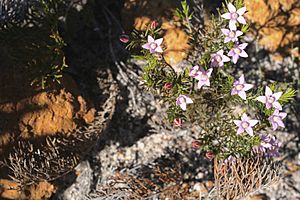Philotheca pinoides facts for kids
Quick facts for kids Philotheca pinoides |
|
|---|---|
 |
|
| Scientific classification | |
| Genus: |
Philotheca
|
| Species: |
pinoides
|
| Synonyms | |
|
|
Philotheca pinoides is a type of flowering plant. It belongs to the Rutaceae family. This plant is found only in the south-west part of Western Australia. It is a small, upright shrub. Its leaves look like needles and have tiny bumps. The flowers are pale pink or red. They grow alone or in small groups, usually at the end of the plant's branches.
Contents
What it Looks Like
Philotheca pinoides is an upright shrub. It usually grows to be about 30 to 60 centimeters (12 to 24 inches) tall. Its branches have small, bumpy glands.
Leaves and Flowers
The leaves of this plant are shaped like needles. They are about 10 millimeters (0.4 inches) long. The top surface of the leaves has a groove.
The flowers grow alone or in groups of up to three. They appear where a leaf meets the stem. Each flower sits on a small stalk called a pedicel. This stalk is about 4 to 7 millimeters long.
Each flower has five sepals. Sepals are small, leaf-like parts that protect the flower bud. These sepals are shaped like wide triangles and are about 1.5 millimeters long. The flowers also have five petals. These petals are pale pink or red and are about 6 millimeters long. Inside the flower, there are ten stamens. Stamens are the parts that produce pollen, and they have a few hairs.
Flowering and Fruit
Philotheca pinoides flowers from August to October. After flowering, the plant produces a fruit. This fruit is about 6 millimeters long.
How it Got its Name
This plant was first officially described in 1970. A scientist named Paul Wilson gave it the name Eriostemon pinoides. He wrote about it in a science journal called Nuytsia. The information came from plants collected by Charles Gardner in 1949. He found them on top of Mount Peron.
Later, in 1998, Paul Wilson changed the plant's name. He renamed it Philotheca pinoides in the same journal.
Where it Grows
Philotheca pinoides grows in areas called heathland. You can find it between Eneabba and Badgingarra. Both of these places are in the south-west of Western Australia.
Conservation Status
The Government of Western Australia's Department of Parks and Wildlife has classified Philotheca pinoides as "not threatened." This means it is not currently at risk of disappearing.

